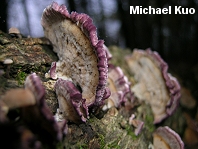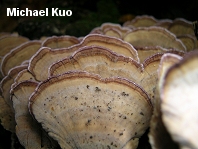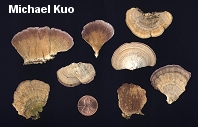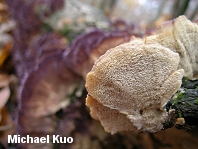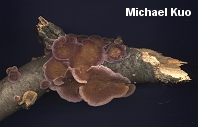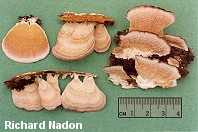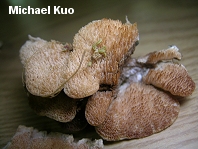| Major Groups > Polypores > Trichaptum biforme |

|
Trichaptum biforme [ Basidiomycetes > Polyporales > Polyporaceae > Trichaptum . . . ] by Michael Kuo Viewed from above, Trichaptum biforme is a bland, boring polypore, reminiscent of any number of faded, ubiquitous, Turkey-Tail-ish species. If you were an ant, however, you might have occasion to crawl underneath this fungus and bask in its beauty; the fresh pore surface is a gorgeous lilac purple. Though there is no taxonomic significance to the idea, other covertly purple mushrooms include the gilled mushroom Laccaria ochropurpurea, which by maturity demonstrates its purple tendencies only to observers who turn it over to look at the gills, and Hapalopilus nidulans, which is so shy about its purple aspirations that a drop of KOH must be applied to coax it into a demonstration Sadly, the purple shades of Trichaptum biforme soon fade, leaving only the slightest hints of their former glory. Trichaptum abietinum grows on conifer wood; it has a grayer, hairier cap surface, and retains its purple shades longer. Trichaptum subchartaceum is larger, grows on the wood of Populus species, and does not develop teeth or spines on its pore surface. Description: Ecology: Saprobic; growing in overlapping clusters on hardwood logs and stumps; late spring, summer and fall; found in all 50 of the United States and all the Canadian provinces; in eastern North America it is one of the most commonly encountered fungi. Trichaptum biforme is a voracious decomposer of dead wood. It causes a straw colored sapwood rot in standing trees. Cap: Up to 6 cm across and 3 mm thick; more or less semicircular, irregularly bracket-shaped, or kidney-shaped; flattened-convex; hairy, finely hairy or fairly smooth; with zones of whitish to grayish white colors; the margin sometimes pale lilac. Pore Surface: Purple to lilac, with the strongest shades near the margin; fading to buff or brownish in age; with 3-5 angular pores per mm; usually eroding and developing spines or teeth with maturity (sometimes appearing more like a toothed mushroom than a polypore); not bruising. Stem: Absent. Flesh: Whitish; tough and leathery. Chemical Reactions: KOH negative to pale yellowish on flesh and cap surface. Spore Print: White. Microscopic Features: Spores 6-8 x 2-2.5 µ; smooth; cylindric to slightly allantoid; hyaline in KOH; inamyloid. Cystidia abundant; up to 35 x 5 µ; more or less fusoid; apically encrusted. Hyphal system dimitic. REFERENCES: (Fries, 1833) Ryvarden, 1972. (Saccardo, 1905; Overholts, 1953; Smith, Smith & Weber, 1981; Gilbertson & Ryvarden, 1987; Phillips, 1991/2005; Lincoff, 1992; Metzler & Metzler, 1992; Evenson, 1997; Barron, 1999; Roody, 2003; McNeil, 2006; Miller & Miller, 2006; Binion et al., 2008; Kuo & Methven, 2010.) Herb. Kuo 07170404, 06090703. This site contains no information about the edibility or toxicity of mushrooms. |
© MushroomExpert.Com |
|
Cite this page as: Kuo, M. (2004, August). Trichaptum biforme. Retrieved from the MushroomExpert.Com Web site: http://www.mushroomexpert.com/trichaptum_biforme.html |
